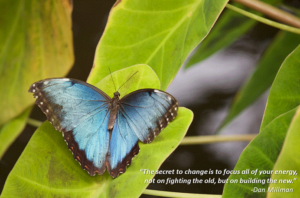Growth comes through Change
I have often marveled at the metamorphosis that is represented by the butterfly. The drastic change from egg, to larva to chrysalis to butterfly is fascinating. Most of us think simply of the change from caterpillar (sludging on leaves and eating all in sight) to butterfly (flying gracefully, beautifully and lilting among the flowers). Like all lifeforms it is a cycle. The egg (the size of a pinpoint for the Monarch butterfly) opens into a larva (what we think of as the caterpillar and initially not much bigger than the egg). During this larva stage the Monarch will grow from a pinhead to about two inches. The phase that is different from most species is the chrysalis or cocoon stage, kind of like adolescence for humans except as humans we work hard to help teenagers through life changes rather than put them in an enclosed container walled off from society. From the cocoon (with much apparent strain and struggle) the butterfly emerges. The butterfly’s job is to seek out the best place to lay eggs. Repeat the process.
Change happens much the same way for humans except that for many of the changes that humans face the process includes an element of choice. The best-known theory of change is the Transtheoretical Model developed by James Prochaska and others. This model plays out the states as precontemplation (no thoughts of change), contemplation (maybe change should happen), preparation (how should this change happen), action (make the change), and maintenance (keep the change happening) and termination (the problem that the change was needed for no longer exists). Another critical element of the model is relapse (reverting to previous behavior) which can happen at any stage of the model. As an example of how the theory works could be making yoga a consistent practice.
Precontemplation may not seem like a stage of change because it is a precursor to change that occurs before an aha moment that signals that change can be an improvement. In the precontemplation stage we are unaware that change even needs to happen. At this stage we may know that yoga exists, but we have had no thoughts of adding it to our routine.
The aha moment is when precontemplation moves into the contemplation stage. The contemplation stage indicates awareness that change would be a good thing. This stage also begins the gathering of information. At this stage we begin researching how yoga can be helpful, whether we want to seek out a class or do it at home.
Moving from the contemplation stage to the preparation stage occurs as more thought is given to the decision and a stronger commitment is made to follow through. An additional element of preparation may be gathering tools needed for action. At this stage we may procure appropriate attire and accessories for yoga, maybe buying a yoga mat and flexible clothing.
The preparation stage moves into the action stage when, well, actions are taken. The action stage is when the practice of yoga at home or in a class takes place.
The maintenance stage is the process of making a change a habit. For this illustration the maintenance stage would indicate a consistent practice of yoga.
The final stage of TTM is the termination stage. This is not a termination of the new habit, but rather a termination of the concern that the new habit addressed. At this stage the act of not doing yoga would be distressful, creating a feeling of loss.
It is easy to see how relapse can occur at any of the stages. A new healthy habit may be considered (contemplation stage) and then the thoughts wander away. Or perhaps the new habit was not only considered but also tools were obtained (preparation stage) and yet no action was taken. Maybe action was taken a few times and could not be maintained. Relapse is not failure, rather it is an invitation to revise and redo.





